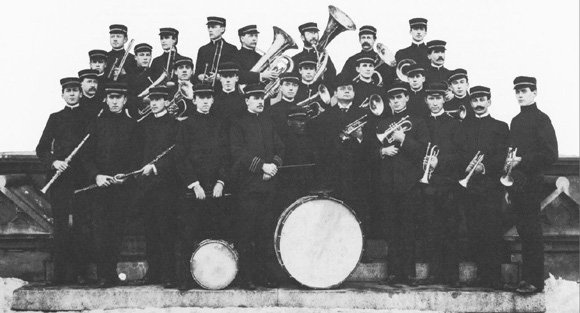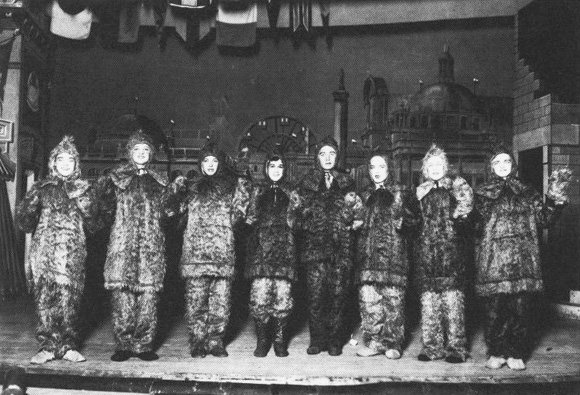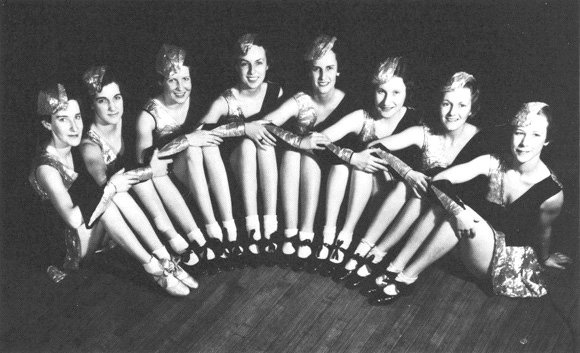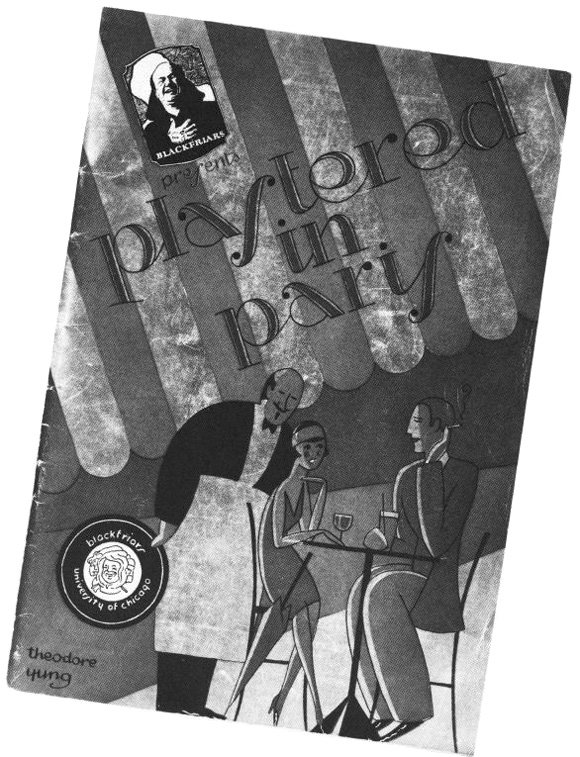The Performing Arts
Music came early to the University. In October 1892, the first two student music groups - the University Chorus and the Glee and Mandolin Club - were formed. Later that year they were joined by the University Choir, and in 1893 by the Serenade Club, the University Quartette, an Octette, and a fifteen-piece orchestra. The decade was capped by the formation of the marching band, organized in 1898 under the aegis of President Harper, an enthusiastic amateur cornet player. The band quickly became one of the most popular groups on campus and could be found at most major events such as football games.
Small, informal clubs like the Banjo Quintette, the Women's Harpsichord Club, and Women's Banjo Club also emerged as complements to the major musical organizations. Like the Glee Club, Chorus, and Choir, they gave performances and fulfilled the universal objective of all campus musical groups by offering a release for performers and audience alike from the rigors of academic life. At the same lime, campus music groups expanded the student body's appreciation for music and enhanced the musical talent of the musicians and singers.
In 1920, when Walter Reckless called a meeting of musicians to form a new orchestra, the popularity of student music groups had reached a peak not only in the number of participants but also in the range of music offered. Reckless succeeded in putting together a quality, all-student orchestra of about thirty members in its first year. After its initial performance at the Settlement Night Vaudeville, the University Orchestra quickly became one of the leaders in student music.
In 1931, the University created an academic Department of Music, which among other duties assumed supervision of student music groups. Under the direction of Carl Bricken, the department's chair, students formed the highly respected seventy-five piece University of Chicago Symphony Orchestra. In addition, the student choir groups and the newly organized University Singers thrived within this setting. The notable exception to this pattern was the band, which deteriorated quickly after the demise of intercollegiate football on campus. Re-established in 1955, the band represented the revival of a longstanding University musical tradition.
A new wave of interest in student music arose in the 1960s and continues today. The University Symphony Orchestra gives quarterly public performances and has toured Europe. A score of smaller ensembles, including the Collegium Musicum and the Motet Choir, perform regularly in the new Goodspeed Recital Hall and elsewhere on campus. Student music continues to thrive on the Quadrangles.
The tradition of student theater on campus was launched with satiric laughter. Among the earliest student dramatic productions were a Washington's Birthday Souvenir mocking the founding of the University and The New Cosmology portraying prominent faculty members in the guise of Greek gods.
Musical comedy made its debut in 1899 with The Deceitful Dean, an entertainment featuring such familiar campus characters as Registrar A. Bludsucker, Examiner Lawrence Lowmarker, and Tabitha Teachem, the dour head of Mary Jane House. The east of The Academic Alchemist (1900) followed with a still more elaborate comic production focused on United States President William McKingly, University President William Brainy Driver, Secretary to the President H. E. Runsitall, and Uriah Wiley, the mysterious Head Professor of Alchemy
Some of the most popular shows were the original musical comedies presented by the Blackfriars, an all-male troupe founded in 1903. Inspired by collegiate groups such as Harvard's Hasty Pudding and Pennsylvania's Mask and Wig, the Blackfriars membership included one man from each fraternity and any actors "fitted for amusing themselves and others." Their early productions established the Blackfriars as masters of campus burlesque, with men playing all the roles. The exotic Eastern setting of The Rushing of Boxes (1906) recalled the University's Egyptian Expedition undertaken by Professor James Henry Breasted. Sure Enough Segregation (1907) provided a mordant commentary on the brief experiment with classroom separation of men and women in the Junior College.
Blackfriars shows became increasingly sophisticated after 1910, and in the 1920s directing, costuming, and staging were placed entirely in the hands of professionals. The tradition of handsome males and more handsome females was sustained through productions including Wallie, Watch Out! (1926), an exuberant skewering of flappers, fraternities, and the Florida land boom; Mr. Cinderella (1929), which introduced the infectious Midway Shuffle; Captain Kidd, Jr. (1931), starring lithe Joseph Salek (PhB 1932) as Zee Zee; topical shows such as In Brains We Trust (1935) and Fascist and Furious (1936); and the torrid Mexican romance of Love Over the Line (1939).
The Blackfriars tradition, neglected during World War II, sprang back to life in 1957 with a production of Gamma Delta Iota. Alternating between presentations of original comedies, Broadway musicals, and revivals of earlier Blackfriars hits, the revived company has produced such shows as The Boys from Syracuse (1967), What U. C. Is What You Get (1973), and Publish or Perish (1976)
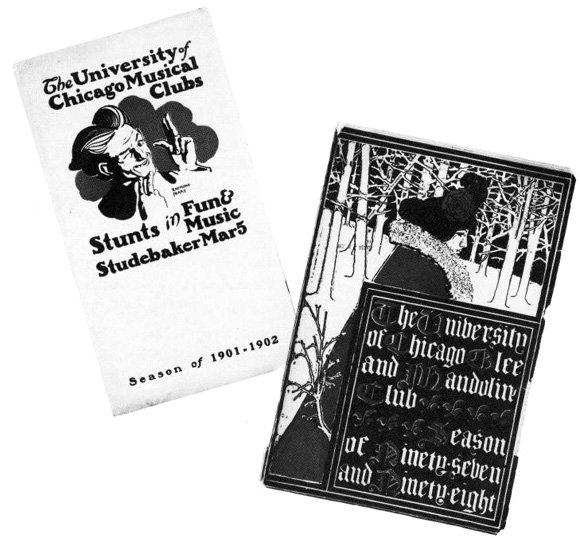
Musical Clubs' Show program, March 5, 1902. The ninth annual Musical Clubs' Show gave students a sample of the music being performed on campus by the Glee Club, Mandolin Club, and Banjo Quintette. Samuel N. Harper (AB 1902), son of President Harper, was assistant manager of the combined clubs.
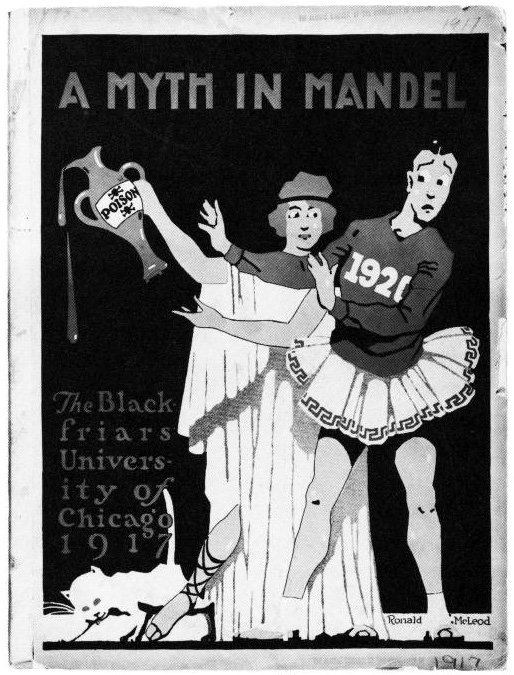
Set in Chicago during the classical age, the score of the fourteenth annual Blackfriars show presented an anachronistic melange of tunes including "My Athenian Maid," "When Helen of Troy Was a Girl," and "Research," sung by Professor Appleby and the Grinds.
In 1923 proliferating student theater groups were brought together under the Dramatic Association, a coordinating organization which helped arrange scheduling and production details. Each component of the Association was allowed to retain its own distinctive identity: the Gargoyles (the descendant of the Dramatic Club) admitted both men and women; the Tower Players admitted only men; while the Mirror Review, a group responsible for staging spectacular chorus-line musicals each spring, was composed entirely of women. By 1936 , the Dramatic Association had an impressive total of 300 members and listed among its alumni professional actors and actresses such as Milton Sills (PhB 1931, JD 1932 ), Frances Dee (Ex 1931), Emily Tart (PhB 1919), Marie Adels (Ex 1926), Margaret Letitia Ide (G 1926 Lab School), Lucite Hoerr (PhB 1930), James Carlin Crandall (PhB 1920), Frank Parker (PhB 1923, AM 1927), Fred Handschy (PhB 1926), Will Geer (SB 1924), and Fritz Leiber (PhB 1932).
Drama at the University of Chicago expanded again in 1946 with the formation of University Theater, founded by George Blair. University Theater, like its numerous dramatic predecessors, placed an emphasis on innovative and professional productions. But UT's emphasis on interpretations of classical drama from Shakespeare and Marlowe to T. S. Eliot differentiated it from the wildly original scripts of the Blackfriars. UT was also considered to be a literary theater, distinguishing it from the more popular fare of the Dramatic Association.
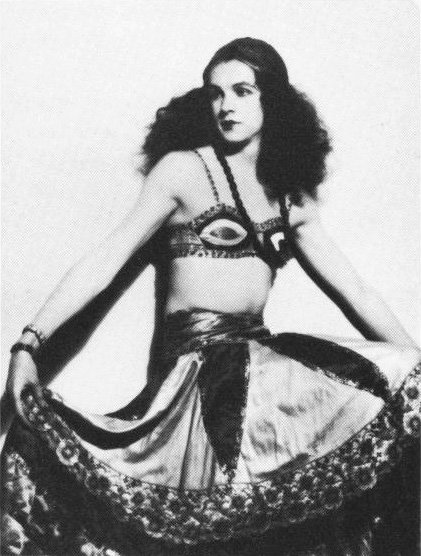
Pirates, moonlight, and swaying palms provided the perfect backdrop for the character of Zee Zee, "the alluring and sensuous Caribbean maiden" who danced, the Blackfriars said, "with languorous and dreamy quality to the soft tunes of the West Indies."
The postwar years were also a fruitful time for student comedy. In 1950, students organized a new theatrical venture, Tonight at 8:30, led by a group that included Paul Sills (Ex 1952), Severn Darden (Ex 1950), Ed Asner (Ex 1948), and Mike Nichols (Ex 1953), and began the series of stage experiments that soon moved to off-campus locations. The Playwright's Theater, the Compass Players, and eventually the Second City improvisational troupes were the famous progeny of this student enterprise.
Student drama took another important step in 1955, when Hutchinson Court was converted into a summer performance space under the name Court Theatre. Through the 1960s, Court presented a succession of plays drawn from the classics and staged by a resourceful group of students, amateurs, and a sprinkling of professional actors. In the 1970s, Court Theatre was transformed into a year-round professional and resident ensemble, and in 1981 it moved info permanent quarters in its new building al the north edge of the campus. On other stages, student theater retained its vitality with continuing productions of University Theater in Reynolds Club and new experimental ventures such as Off Off Campus.
Blackfriars shows of the 1920s were "becoming jazzier," proclaimed this program, and "the stages featured are each year more sensational, the choruses larger and better trained." Plastered in Paris met the challenge of rising expectations with a satiric skewering of expatriate Americans on the Left Bank.
